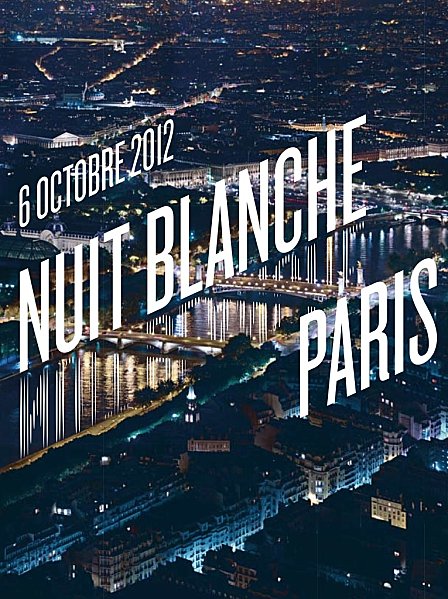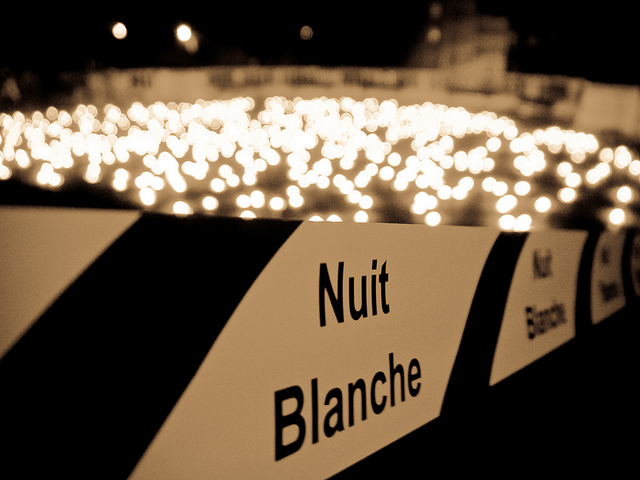Two art-hunters take Paris

1. Patrick Errington explores the left bank
This was my first time in Paris for the much-hyped Nuit Blanche festival and my goal was to stay general and experience as much as I could. I’ll admit to rather sodden spirits as the rain from the morning clung to the city through the afternoon and into the evening, but once united with my small crew of cohorts, we resolved to take to heart the message glowing above the Samaritan building: “du soleil dans la nuit.”
We arrived at the Bibliothèque nationale de France (BnF), the first and only preplanned destination, to find a surprising number also bringing a little sun into the night. Already, a queue stretched from the doors of one of the towers, umbrellas looking like a huddle of mismatched mushrooms. As we waited (not long—the queue did move surprisingly quickly) to take the lift to the specially opened eighteenth floor of the BnF tower, we caught the first glimpses of what Paris had in store: the red glow of a light installation under the passerelle Simone de Beauvoir and, on the boardwalk, part of Julie Desprairies’ line of dancers along the edge of the stairs performing her Tai-chi-esque choreography dressed head-to-toe in bright spandex.
The top of the tower itself did provide a not-often-seen view of the city, but with the shrouding grey drizzle it did not unfurl the spectacularly lit cityscape we had hoped. The multicoloured smoke from the factory in Ivry on the outskirts of town did stand out against the grey, however, because of the rather strange choice to use north and easternmost tower of the four at the BnF, the greater highlights and eye-catching monuments were blocked by the others towers even if not by the rain. Even the mayor of Paris, Bertrand Delanoë, seemed underwhelmed when we snagged a glimpse of him as we suddenly found ourselves caught up in his entourage of photographers and guards.
After making our escape back to ground level and spying a brazen Parisian try to join the dancers along the boardwalk, we moved down along the river toward the centre of town. On a whim, we stopped in at the Université de Pierre et Marie Curie, intrigued by the wash of neon lights and strange sounds sluicing out the door. Inside, we found one of the more intriguing installations of the evening: a soundscape presentation designed by Michel Risse and the company Décor Sonore. Using the architecture of the courtyard and the enclosing, modern buildings, performers and recordings of various mechanical white noises presented a veritable garden of sound and light in an attempt to display the semi-mythical ‘Effet Sharawadji.’ While I still have no idea what this effect was meant to be, nor the meaning (if there is one) of the stormtrooper style costumes of the performers, the effects of the sound reverberating through the smoky, neon and metal space was fascinating. At the end, we had the option of taking in another view of the city from the university tower, but as the rain continued, we decided to forego the queue in favour of continuing our ambling along the river.
Another installation we were all keen to see was the much anticipated foam sculpture, the ‘bouquet final’ of Michel Blazy. On the way, though, we were arrested by the sight of fire exploding along the river. Designed and created by the much-lauded Groupe F—the pyrotechnic team made famous by their special effects for events like the Olympic Games in Athens and Turin, and the year 2000 New Years celebrations in Paris—their skeletal boat lit up the river in gouts of fire. It made quite a show, spinning slowly between the bridges spewing flames to the awe of the gathered crowds before racing along down the Seine.
We did eventually get to Blazy’s foam sculpture, housed in the classical walls of the City Hall of the fourth arrondissement. Like the fire boat or the ‘Effet Sharawadji,’ I’m not quite sure how to define it as ‘art,’ but Blazy, who is known especially for his installations constructed of household materials, did manage to create a stunning structure out of a simple scaffold and what seemed to be the entire city’s supply of dish soap. Looking from a distance like ice or snow, the foam pouring from the scaffold was awe-inspiring. However, I was equally fascinated by the murals and the stunning classical architecture of the building, and the juxtaposition with the soapy mass in the centre was, to me, slightly off-putting.
It was just after that, when we stepped outside again, the time nearly 3 a.m., that the enormity of the event struck me. Here we were, in the middle of a city whose artistic history so often overwhelms its current endeavours, and yet even in the rain and in the wee hours of the morning the streets are flooded with people celebrating art in all its forms. I’m not saying it all appealed to me personally—I still don’t know if you can call a foamy scaffold ‘art’ any more than I can the soap suds as I wash dishes—but that’s just the nature of art, and people are out supporting it, creating, exploring. And that’s the sun I saw shining through the night.

2. Stephanie Papa finds Philip Glass
You have to find an engine for change. And that’s what collaborative work does. Whatever we do together will make us different.
– Philip Glass, New York Times Interview, October 5, 2012
Another piece of sheet music lilted to the floor, on top of the others piling up beside the piano. It was almost 2am and I was staring at the ceiling of Collège des Bernadins; the strangers and I were laid out on our backs as stargazing if in a field. Some had been there for the entire five hours, but I, a little less faithful, had showed up late. After two consecutive years of mediocre Nuit Blanche experiences (either the allure of an artistic all-nighter didn’t deliver, or it was simply my bad luck), I had been in no hurry to queue up in the rain and leave ambling around town up to chance. This year, however, the 11th edition of Nuit Blanche seemed more promising. Mysterious happenings on the menu included paper falcon making, a pirogue boat installation from St. Denis to Canal Ourcq and much more. Something on the program especially caught my eye: a Philip Glass marathon concert, “Alterminimalismes 12.”
I was coming from the usual Nuit Blanche installments that night which seem to get lost in translation—a neon dragon made of mesh, a courtyard where one very wet woman walked through a sheet with cloud silhouettes projected on it. The expos in certain church also seemed to be hit-or-miss. L’église Notre-Dame-des-Blancs-Manteaux had an impressive group of choirs performing consecutively, including a children’s choir singing Fauré arrangements that left most of the Nuit Blanchers breathless. However, the other, more famous Notre Dame’s late-night installation missed the opportunity to risk the avant-garde, projecting a film explaining the church’s history. (Yawn). Yet when I managed to cross the Seine and reached Collège des Bernadins, “Glasstroduction” was well on its way, and the audience well sedated. The crowd was free to come and go, parents carried out passed-out children draped over the shoulders, couples tried to find their places among the lounging listeners.
Philip Glass, the composer, is no stranger to Paris, having moved to the city in 1964 for a short period to study with renowned composer Nadia Boulanger and where he eventually met sitarist, Ravi Shankar. The hall of the Collège was a stunning setting for Glass’s compositions as well, the acoustics being a key element for his tones to orbit and swell.
Only pausing once or twice to take a sip of water in between movements, the pianist Nicolas Horvath went through pages of scores. The final cycle, most of which was played with only his right hand, seemed almost effortless. The performance in its entirety, from “Glassworks,” to his work for film, up to his piece “600 lines,” also illuminated Glass’s interest in Buddhism; the consistent repetition of blurred musical sequences was almost like hours of meditation, leaving most people transfixed. Horvath couldn’t help but continue even after the last note, playing the exit music as we filed out of the hall into the night. The last survivors crouched on the ground, sifting through the sheet music to answer the question that had been engrossing them: what was actually written on the page?

You must log in to post a comment.